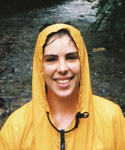A little bit about me:

Contact: email, CV, twitter (my tweeting is… minimal)
Howdy, I’m Christine O’Connell, a PhD candidate in the Department of Ecology, Evolution and Behavior at the University of Minnesota. I am also a research fellow with the Global Landscape Initiative at UMN’s Institute on the Environment. Previously, I received a B.S. from Stanford University in Earth Systems with a focus in Biology and, prior to returning to graduate school, spent several years teaching high school biology in an urban charter school in Brooklyn, N.Y. as a Teach For America corps member. Life as an ecologist is awesome.
A little bit about my field work:
I use ecosystem ecology to explore the environmental impacts of changing land use in the tropics. More specifically, my dissertation investigates the effects of increased agricultural production on the Amazon’s contribution to global climate, biodiversity and nitrogen cycling, using a combination of statistical modeling and field work in Mato Grosso, Brazil. This blog focuses on letting family, friends, and colleagues get a glimpse into the latter.
The Amazon is the world’s largest contiguous tropical forest and is generally amazing: Amazonia stores an enormous amount of sequestered carbon (~100 PgC in aboveground plants alone!), is a hotspot of terrestrial biodiversity, and dynamically influences how water and nutrients move through the terrestrial biosphere. (See Malhi et al., 2006; Hubbell et al., 2008; Foley et al., 2007; among others.)

But it’s also a frontier of rapid changes in land use and land cover. A portion of my dissertation research looks at the ecological effects of deforestation to create new agricultural lands in the Amazon. These effects are varied – everything from biodiversity loss to changes in rainfall. I work with lots of data to get at some of these effects.
My field work, however, considers a different type of land use/land cover change. What about the lands in the Amazon that have already been deforested? A lot of that deforested land is now devoted to growing soybeans. And those soybean farms, in the last 10 years, have rapidly intensified – that is, have become farms that look a lot more like the state-of-the-art, mechanized, fertilizer- and herbicide-using farms of the midwestern United States. Which is interesting, since we don’t understand very well what happens to tropical soils when we treat them like soils from the temperate zone. And where there’s interesting, there are curious scientists!

Hence, I’ll be spending time in Mato Grosso, Brazil, in the southeastern Amazon, on a 32,000 hectare industrial farm run by a major international soybean company. The farm is surrounded by epic Amazonia. It is RAD.
More specifically, my project looks at how emissions of a greenhouse gas, nitrous oxide, change as this ecosystem goes from being a tropical forest to a soybean field to a soybean field that also has corn planted on it in the off-season. This means a lot of capturing gas emissions from soils, a lot of digging up soil, and a lot of tromping through fields and forests to figure out how and why nitrogen is moving around differently depending on what we’re doing to the land. Awesome!
Thanks for reading, y’all. This is going to be sweeeeeeet!


What a great opportunity. In DOI we give attention to a related topic of desertification
Enjoy your time. Kathy P
Thanks, Kathy! I’ll have to pick your brain about whether DOI’s desertification work has looked at cattle stocking density or rotational crop/grazing systems at all – two big levers that folks in Brazil talk about a lot as possible ways of improving the sustainability of the pasturelands here. I have to admit I’m a bad grad student in that I don’t know as much about it as I ought to. :)